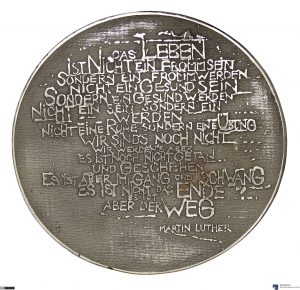Artist Anna Franziska Schwarzbach has become the second German to win the American Numismatic Society’s (ANS) J. Sanford Saltus Award for outstanding achievement in medal art.
In addition to her work as a medallist, Schwarzbach is an architect and sculptor whose work is displayed in public spaces, including universities and museums, across Germany. She is one of 11 women who have received the prestigious honour, which has been awarded since 1913.
“She has found success a number of times already with her ideas,” according to a YouTube video posted by the Berlin State Museums, which adds Schwarzbach “loves rough sculptures as much as the details in her work, both in her sculptures and her medallic art.”
After receiving the Saltus Award during a Dec. 3 ceremony in Berlin, she explained her desire for medals “to be an acknowledged piece of art, not just a numismatic object in the form of a circle.”
“It is a kind of art which you can hold, or need to hold, to capture the reflection and reaction of light.”
BORN INTO AN ARTIST’S FAMILY
In 1949, Schwarzbach was born into an artist’s household in Saxonia, Germany.
Her father, Hans Brockhage, was a well-known sculptor in East Germany, leading Schwarzbach down the path of studying architecture and then art.
Since the 1970s, she has worked as a sculptor and medallist in Berlin, and since 1985, she has devoted herself to numismatic studies.
“Since then, she has done much to support and maintain the science of coins and medals,” adds the Berlin State Museums video.
Her significant oeuvre as a medallist delves deep into German history, but her main focus is portraiture—particularly of often-ignored subjects. Unusual, too, is her preferred medium of cast iron, which since the 19th century has been used as an artistic medium in Germany (especially in Berlin, where it was promoted by Karl Friedrich Schinkel).
“One of her award-winning medals shows the portrait of Martin Luther, which was cast in silver and iron,” adds the video. “The iron example was produced in the foundry in Lauchhammer.”
Engraved in German, the medal’s inscription on the back reads, “LIFE / IS NOT A RELIGIOUS / BUT A RELIGIOUS / NOT A HEALTHY BEING / BUT A BECOMING HEALTHY / NOT A BE BUT A / BECOMING / NOT A CALM BUT AN EXERCISE / WE ARE NOT YET / WE WILL ´ BUT / IT HAS NOT DONE YET / AND DONE / IT IS BUT IN PROGRESS AND VIBRANT / IT IS NOT THE END / BUT THE WAY / MARTIN LUTHER.”
According to the museum, which has a specimen example in its “Münzkabinett” collection, the text is found in the Weimar edition of Luther’s writings.
The specimen measures 109 millimetres by 105 millimetres with a weight of 258 grams.
PAST SALTUS WINNERS
Other female Saltus Award recipients include:
- Laura Fraser, of the United States (1926);
- Gertrude Lathrop, of the United States (1950);
- Karen Worth, of the United States (1979);
- Ewa Olszewska-Borys, of Poland (1993);
- Marianne Letterie, of the Netherlands (1994);
- Nicola Moss, of the United Kingdom (1996);
- Leonda Finke, of the United States (1997);
- Jeanne Stevens-Sollman, of the United States (1999);
- Dora de Pédery-Hunt, of Canada (2003); and
- Mashiko, of the United States (2019).
Schwarzbach is the second German sculptor to receive the honour since Bernd Göbel in 2000.


